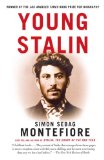Summary | Excerpt | Reviews | Beyond the Book | Readalikes | Genres & Themes | Author Bio

Critics' Opinion:
Readers' Opinion:
First Published:
Oct 2007, 496 pages
Paperback:
Oct 2008, 528 pages
 Book Reviewed by:
Book Reviewed by:
Vy Armour
Buy This Book
PROLOGUE: The Bank Robbery
At 10:30 a.m. on the sultry morning of Wednesday, 26 June 1907, in the seething central square of Tiflis, a dashing mustachioed cavalry captain in boots and jodhpurs, wielding a big Circassian sabre, performed tricks on horseback, joking with two pretty, well-dressed Georgian girls who twirled gaudy parasols–while fingering Mauser pistols hidden in their dresses.
Raffish young men in bright peasant blouses and wide sailor-style trousers waited on the street corners, cradling secreted revolvers and grenades. At the louche Tilipuchuri Tavern on the square, a crew of heavily armed gangsters took over the cellar bar, gaily inviting passers-by to join them for drinks. All of them were waiting to carry out the first exploit by Josef Djugashvili, aged twenty-nine, later known as Stalin, to win the attention of the world.[1]
Few outside the gang knew of the plan that day for a criminal terrorist “spectacular,” but Stalin had worked on it for months. One man who did know the broad plan was Vladimir Lenin, the leader of the Bolshevik Party,[2] hiding in a villa in Kuokola, Finland, far to the north. Days earlier, in Berlin, and then in London, Lenin had secretly met with Stalin to order the big heist, even though their Social-Democratic Party had just strictly banned all “expropriations,” the euphemism for bank robberies. But Stalin’s operations, heists and killings, always conducted with meticulous attention to detail and secrecy, had made him the “main financier of the Bolshevik Centre.”[3]
The events that day would make headlines all over the globe, literally shake Tiflis to its foundations, and further shatter the fragmented Social-Democrats into warring factions: that day would both make Stalin’s career and almost ruin it–a watershed in his life.
In Yerevan Square, the twenty brigands who formed the core of Stalin’s gang, known as “the Outfit,” took up positions as their lookouts peered down Golovinsky Prospect, Tiflis’s elegant main street, past the white Italianate splendour of the Viceroy’s Palace. They awaited the clatter of a stagecoach and its squadron of galloping Cossacks. The army captain with the Circassian sabre caracoled on his horse before dismounting to stroll the fashionable boulevard.
Every street corner was guarded by a Cossack or policeman: the authorities were ready. Something had been expected since January. The informers and agents of the Tsar’s secret police, the Okhrana, and his uniformed political police, the Gendarmes, delivered copious reports about the clandestine plots and feuds of the gangs of revolutionaries and criminals. In the misty twilight of this underground, the worlds of bandit and terrorist had merged and it was hard to tell tricks from truth. But there had been “chatter” about a “spectacular”–as today’s intelligence experts would put it–for months.
On that dazzling steamy morning, the Oriental colour of Tiflis (now Tbilisi, the capital of the Republic of Georgia) hardly seemed to belong to the same world as the Tsar’s capital, St. Petersburg, a thousand miles away. The older streets, without running water or electricity, wound up the slopes of Mtatsminda, Holy Mountain, until they were impossibly steep, full of crookedly picturesque houses weighed down with balconies, entwined with old vines. Tiflis was a big village where everyone knew everyone else.
Just behind the military headquarters, on genteel Freilinskaya Street, a stone’s throw from the square, lived Stalin’s wife, a pretty young Georgian dressmaker named Kato Svanidze, and their newborn son, Yakov. Theirs was a true love match: despite his black moods, Stalin was devoted to Kato, who admired and shared his revolutionary fervour. As she sunned herself and the baby on her balcony, her husband was about to give her, and Tiflis itself, an unholy shock.
Excerpted from Young Stalin by Simon Sebag Montefiore Copyright © 2007 by Simon Sebag Montefiore. Excerpted by permission of Knopf, a division of Random House, Inc. All rights reserved. No part of this excerpt may be reproduced or reprinted without permission in writing from the publisher.





The House on Biscayne Bay
by Chanel Cleeton
As death stalks a gothic mansion in Miami, the lives of two women intertwine as the past and present collide.

The Flower Sisters
by Michelle Collins Anderson
From the new Fannie Flagg of the Ozarks, a richly-woven story of family, forgiveness, and reinvention.

The Funeral Cryer by Wenyan Lu
Debut novelist Wenyan Lu brings us this witty yet profound story about one woman's midlife reawakening in contemporary rural China.
Your guide toexceptional books
BookBrowse seeks out and recommends the best in contemporary fiction and nonfiction—books that not only engage and entertain but also deepen our understanding of ourselves and the world around us.